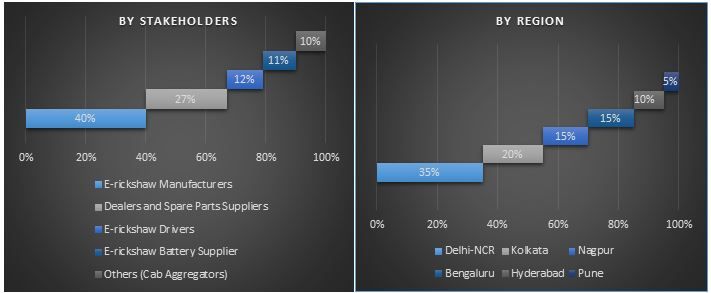- Home
- About Us
- Industry
- Services
- Reading
- Contact Us
India Electric Rickshaw (E-Rickshaw) Market: Current Analysis and Forecast (2022-2028)
Emphasis on Vehicle Type (Passenger Carrier E-Rickshaw, Load Carrier E-Rickshaw), Battery Type (Sealed Lead Acid Battery E-Rickshaw, Li-Ion Battery E-Rickshaw), Ownership Type (Owned E-Rickshaw, Rented E-Rickshaw) and Region
India E-Rickshaw market crossed USD 2.5 billion mark in 2018 and is expected to grow at a CAGR of XX.0% during the forecast period 2019-2025. E-Rickshaw is a flexible, non-polluting and affordable means of Intermediate Para-Transit (IPT) system. E-Rickshaw is the latest entry in the Indian road transportation system. Since E-Rickshaw has been introduced in India, it has been playing a significant role in solving the issue of last mile intercity connectivity. Since 2010, E-Rickshaw has been operational in India, mostly in Delhi-NCR region. Since then, this vehicle has gained immense popularity due to environment friendly nature along with its potential to curb the carbon footprint as it is battery operated. Today, E-Rickshaw has become one of the most preferred modes of transportation in major urban and suburban cities of India. SmartE launched in October 2015, has served over 6 million ‘zero-pollution’ rides. By December 2017, SmartE aims to serve over 3 million commuters per month, through its 1,000 E-Rickshaw fleet. SmartE also aims to roll-out 10,000 vehicles by 2018-end and cross the 100,000 vehicle mark by 2020. At 100,000 vehicles, SmartE will help reduce close to a million tonnes carbon emissions, an equivalent of planting 17 million trees per year.
Across the country, electric rickshaw has become an important part of the transport system and is expected to witness a significant growth over the forecast period on account of government plans such as the National Electric Mobility Plan (NEMP). The government aims to encourage the use of electric vehicles in India along with the commitment to build an efficient electric vehicle network including adequate charging stations and incentives on buying an electric vehicle.
E-rickshaw drivers in Delhi pay 17% lesser rent, compared to normal auto drivers. Also setup or initial investment for e-rickshaw is 50% less that the normal auto rickshaw. Owing to such benefits, penetration of e-rickshaw is expected to increase over the future. The below figure depicts the comparison of initial cost and earning of rickshaw drivers in Delhi-NCR region.
Basic Overview of Initial Cost and Daily Earnings of Rickshaw in Delhi

According to the Society of Manufacturers of Electric Vehicles (SMEV), electric vehicles’ sale doubled in terms of volume in the FY 2017-18 compared to the previous year, majorly through unregulated E-Rickshaw market, with 850,000 E-Rickshaw sold in the specified period. The drivers of the traditional manually-pulled rickshaws have found E-Rickshaws quicker, quieter and easier to keep running as they require less effort, compared to the pedal-cycle rickshaws. This results in more rides and lesser effort for the driver, making E-Rickshaws a rather beneficial investment for them.
The Indian government is currently focusing on promoting electric vehicles in the public transportation and fleets, with emphasis on two-wheelers and three-wheelers, taxis and buses. One of the biggest hurdles in the growth of electric vehicles in India is the dearth of charging and battery-swap stations. The Ministry of Finance is in the process of finalising a plan to spend approximately US$600 million over a period of five years to upgrade the country’s charging infrastructure as well as to provide better subsidies on electric buses. According to BNEF, India had just 425 public charging stations in 2017 and it is expected that with government and public initiatives this number will boost to 2,800 by 2022.
“Passenger Carrier of India E-Rickshaw Market dominated the market in 2018 and is expected to maintain its lead in 2025”
In terms of segmentation by vehicle type, India E-Rickshaw market has been segmented into Passenger and Load carrier. In 2018, passenger carrier dominated the market and is expected to maintain its lead by the year 2025. With growing working population, the need for efficient transportation network has also increased. Hence, as E-Rickshaw is easily available and offers convenient ride, the number of commuters preferring E-Rickshaw for short distance is increasing. All these factors would help better and increased adoption of E-Rickshaw in major Indian cities.
“Amongst battery type, lead acid holds the major share in 2018 while li-ion is expected to grow considerably during the forecast period.”
Based on battery type, India E-Rickshaw market has been segmented into lead acid and li-ion battery. In 2018, lead acid dominated the battery type segment of India E-Rickshaw, generating revenue of US$ 2.17 billion. Though, lead acid battery continues to keep dominating the market over the forecast period while witnessing the benefits offered by li-ion battery. Li-ion battery is expected to grow at the highest CAGR rate during the projection period.
“Owned E-Rickshaw dominated the Indian E-Rickshaw market”
Based on ownership type the Indian E-Rickshaw market is segregated into owned and rented E-Rickshaw. In 2018, owned E-Rickshaw dominated the market and is expected to remain dominant, however rented E-Rickshaw market is expected to witness high adoption in cities such as Delhi-NCR, and other cities in the South Indian region. High income associated with rented E-Rickshaw, as the driver don’t have to bear the maintenance cost would drive the market for rented E-Rickshaw in India.
“Delhi-NCR, Lucknow and Kolkata regions together hold 40% of the market share of India E-Rickshaw Market in 2018 and will continue to do so over the forecast period”
Based on region, detailed analysis has been conducted to understand the overall rate of adoption of E-Rickshaw in major Indian cities including Delhi-NCR, Lucknow, Kolkata, Nagpur, Bengaluru, Pune, Chennai, Hyderabad and other cities. Delhi-NCR captured the maximum market share and is expected to keep leading the India E-Rickshaw market over the projection period. However, with increasing acceptance, it is believed that several cities including Kolkata, Bengaluru, Chennai, and Hyderabad will witness considerable growth in the India E-Rickshaw Market.
Strategies of Cab & Other Aggregators for E-Rickshaw Sector in India

Competitive Landscape- Organised and Unorganised Players
India E-Rickshaw market is very much fragmented. The E-Rickshaw market in India is basically made by assembling its parts together at the manufacturer’s facility. These parts are either imported from China or supplied from local suppliers. India E-Rickshaw market is mainly dominated by local unorganised players with few established players. Some of the organised players operating in this industry include Saera Electric Auto, Atul Auto, Kinetic Green, Terra Motors, Ok Play, Hero Electric and Mahindra & Mahindra, which together hold nearly 15% of the market.
Reasons to buy:
- India E-Rickshaw market study presents the current market size, trend, forecast until 2025 for different Indian cities. The analysis presented in the report is a combination of deep dive secondary research and input from Key Opinion Leader of the industry including the E-Rickshaw drivers
- The report presents a quick review of overall industry performance at one glance
- Initiative of OEM’s vs Aggregators for increasing the overall adoption of E-Rickshaw in India is also presented in the report
- Key benefits of the E-Rickshaw for the drivers are also included in the study along with characteristics of drivers and travelers
- The report covers in-depth analysis of prominent industry peer with a primary focus on key business financials, product portfolio, expansion strategies, and recent developments, revenue and business model
- Detailed examination on drivers, restraints, key trends and opportunities prevailing in the industry
- Examination of industry attractiveness with the help of Porter’s Five Forces analysis
- The study comprehensively covers the market across different segments and sub segments
Customization Options:
India E-Rickshaw market can be customized to the state level or any other market segment. Besides this, UMI understands that you may have your own business need, hence we also provide fully customized solutions to clients.
Table of Content
Research Methodology for India Electric Rickshaw (E-Rickshaw) Market
Analysing historical market, estimation of the current market and forecasting the future market of India E-Rickshaw were the three major steps to create and analyse the overall market of India E-Rickshaw in different Indian cities. An exhaustive secondary research was done to collect the historical market sizing of the E-Rickshaw and overall estimation of the current market. Secondly, to validate these insights, numerous findings and assumptions were taken into consideration. Moreover, exhaustive primary interviews were conducted with industry experts across value chain of the Indian E-Rickshaw market. After all the assumption, market sizing and validation of market numbers through primary interviews, top-down approach was employed to forecast the complete market size of Indian E-Rickshaw market across different cities. Thereafter, market breakdown and data triangulation methods were adopted to estimate and analyse the market size of segments and sub-segments of the sector. Detailed methodology is explained below:
Analysis of Historical Market Size
Step 1: In-Depth Study of Secondary Sources:
Detailed secondary study was conducted to obtain the historical market size of India E-Rickshaw Market through sources including trade journals, news & articles, government publications, economic data, competitor publications, sector reports, regulatory bodies’ publications, safety standard organizations, third-party database and other credible sources/publications.
Step 2: Market Segmentation:
After obtaining historical market size of the overall market, detailed secondary analysis was done to gather historical market insights and share for different segments & sub-segments for India E-Rickshaw Market. The major segments included in the report are E-Rickshaw by vehicle type, E-Rickshaw by battery type for major Indian cities. Further analysis was also done for sub-segments of the major segments of India E-Rickshaw Market.
Step 3: Factor Analysis:
After acquiring the historical market size of different segments and sub-segments, detailed factor analysis was conducted to estimate the current market size of the India E-Rickshaw market. Factor analysis was conducted using dependent and independent variables such the penetration of E-Rickshaw, its availability, passenger preference, and driver/owner benefits. The historical trends of the India E-Rickshaw market and its year-on-year impact on the market size and share in the recent past was analyzed. The demand and supply side scenario was also thoroughly studied.
Current Market Size Estimate & Forecast
Current Market Sizing: Based on the actionable insights from the above 3 steps, we arrived at current market size, key players in major applications and markets, industry’s supply chain, and value chain of the industry. Initiatives undertaken by these players to increase the overall adoption of E-Rickshaw as a mean of public transport. All the required percentage shares, splits, and market breakdowns were determined using the above mentioned secondary approach and were verified through primary interviews.
Estimation & Forecasting: For market estimation and forecast, weightage was assigned to different factors including market dynamics such as drivers & trends, restraints, and opportunities. After analyzing those factors, relevant forecasting techniques i.e. Bottom-up/Top-down was applied to arrive at the market forecast pertaining to 2025 for different segment and sub-segments for different Indian cities. The research methodology adopted to estimate the market size encompasses:
- The industry’s market size, in terms of value and volume and rate of adoption of E-Rickshaw in Indian market
- All percentage shares, splits, and breakdowns of market segments and sub-segments
- Key players in the market as well as major initiatives undertaken by these players. Also, the growth strategies adopted by these players to compete in the ever-growing E-Rickshaw market of India
Market Size and Share Validation
Primary Research: In-depth interviews were conducted with the Key Opinion Leaders (KOLs) including Top Level Executives (CXO/VPs, Sales Head, Marketing Head, Operational Head, and Regional Head etc.). In addition, for primary interviews special focus was given to the E-Rickshaw drivers in the cities such as Delhi-NCR, Pune, Chennai, Bengaluru among other cities. The primary research findings were summarized, and statistical analysis was performed to prove the stated hypothesis. The inputs from primary research were consolidated with secondary findings, hence turning information into actionable insights.
Split of Primary Participants
Market Engineering
The Data Triangulation technique was employed to complete the overall market engineering process and to arrive precise statistical numbers of each segment and sub-segment pertaining to the India E-Rickshaw Market. The Data was split into several segments & sub-segments post studying various parameters and trends in the areas of passenger vehicle and load carrier. Further, based on the battery type, lead acid battery and li-ion battery were also taken into consideration in the evaluation of India E-Rickshaw Market. Owned E-Rickshaw dominated the market over rented E-Rickshaw in major Indian cities.
Main objective of the India E-Rickshaw Market Study
The current & future market trends of the India E-Rickshaw market are pinpointed in the study. The investors can gain strategic insights to base their discretion for investments from the qualitative and quantitative analysis performed in the study. The current and future market trends would determine the overall attractiveness of the market, providing a platform for the industrial participant to exploit the untapped market to benefit as the first mover advantage. Other quantitative goal of the studies includes:
- Analyse the current and forecast market size of India E-Rickshaw market in terms of value and volume
- Analyse the current and forecast market size of different segments and sub-segments of India E-Rickshaw market
- To analyse the different revenue and business models of the E-Rickshaw manufacturers and drivers in different Indian cities
- To understand the initiatives undertaken by OEM’s Vs Aggregators to increase the overall adoption of E-Rickshaw or electric vehicle in public transport in India
- Define and describe the segments and sub-segments considered in the evaluation of Indian E-Rickshaw market
- Anticipate potential risk associated with the India E-Rickshaw market
- Define and analysis of the government regulations for India E-Rickshaw market in different regions/states across India
- Analyse the current and forecast market size of India E-Rickshaw market, in terms of value and volume for different Indian cities including Delhi-NCR, Lucknow, Kolkata, Nagpur, Bengaluru, Pune, Chennai, Hyderabad and others
- Define and analyse the competitive landscape of the India E-Rickshaw market and the growth strategies adopted by the market players to sustain in the ever-growing market
Related Reports
Customers who bought this item also bought











